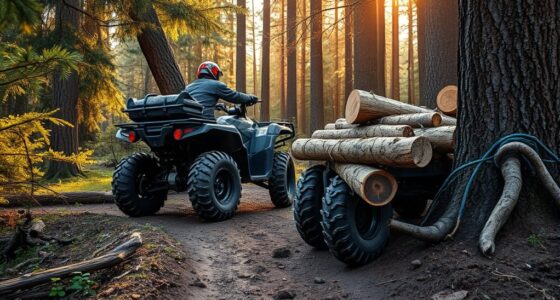To navigate seasonal access, you need to adapt your strategies from winter’s freeze-up to spring and summer’s dry-down. During freeze-up, prioritize checking ice thickness, using safety gear, and staying alert to changing conditions. As the ice thaws, watch for muddy trails, flowing streams, and uneven terrain that increase slip risks. Proper gear maintenance and environmental awareness are key. Keep exploring to discover more tips for staying safe and making the most of each season.
Key Takeaways
- Assess ice thickness and stability through testing and local advisories before engaging in winter activities during freeze-up.
- Monitor temperature trends to determine when ice becomes reliably safe for outdoor access.
- After freeze-up, inspect and maintain equipment like augers and safety gear to ensure optimal performance.
- During dry-down, evaluate trail conditions for mud, flooding, and erosion to plan safe routes.
- Regularly clean and repair gear post-winter to adapt to changing seasonal hazards and maintain safety.

Have you ever wondered how seasonal changes affect your ability to access outdoor destinations? As the seasons shift from winter to spring and into summer, your plans can be heavily influenced by the changing conditions. During freeze-up, the landscape transforms into a winter wonderland, but it also demands careful attention to ice safety. Ice becomes an essential factor when venturing onto frozen lakes, ponds, or rivers. Before heading out, you need to assess the thickness and stability of the ice, which varies with temperature fluctuations and weather conditions. Knowing how to evaluate ice safety isn’t just about looking at the surface; it involves understanding how different conditions impact ice strength. For example, early in the season, ice may be thin and unsafe, even if it looks solid. As temperatures remain cold, ice thickens, but it’s important to keep in mind that fluctuating weather can weaken it unexpectedly. Checking local advisories, testing ice with an auger or chisel, and carrying safety gear like ice picks and a throw rope are essential steps to prevent accidents.
Assess ice safety carefully; conditions change, and early-season ice may be unsafe despite appearing solid.
Equally important during freeze-up is equipment maintenance. Your gear needs to be in top shape to handle winter conditions safely. This includes inspecting your ice auger, ensuring that blades are sharp, and testing your safety gear regularly. Proper equipment maintenance reduces the risk of equipment failure, which could be dangerous when you’re on the ice. Wearing layered, insulated clothing and sturdy boots also makes a difference, especially since cold temperatures can impact your dexterity and comfort. If you’re planning an extended outing, double-check your sleds, skates, or skis to make sure they’re in good condition, and keep emergency supplies handy. Maintaining your gear throughout the season guarantees that it performs reliably when you need it most, giving you peace of mind and allowing you to focus on enjoying your outdoor adventure.
When the season shifts to dry-down, your access changes as the ice melts away, revealing muddy trails, flowing streams, and lush landscapes. This is the time to switch gears, but it also requires attention to different safety concerns. During this period, familiar trails may be flooded or muddy, making navigation tricky. You’ll need to adapt your routes and be mindful of erosion or unstable ground. As the ice recedes, the risk of slipping on wet or uneven surfaces increases, so footwear with good grip becomes essential. It’s also a good idea to check trail conditions before heading out, especially after heavy rain or rapid snowmelt, which can cause flash floods or washouts. Recognizing how seasonal conditions influence outdoor safety is crucial for planning your activities.
This transition period is an excellent time to focus on equipment maintenance, especially cleaning and inspecting your gear after a winter of heavy use. Removing salt and grime from boots and gear prolongs their lifespan, while fixing any damage guarantees safety and comfort. As the environment shifts from frozen to thawed, staying aware of changing conditions helps you avoid hazards. Whether you’re switching from ice fishing to hiking or mountain biking, understanding how seasonal changes influence your outdoor access and maintaining your equipment accordingly makes every adventure safer and more enjoyable.
Frequently Asked Questions
How Do Weather Patterns Influence Freeze-Up and Dry-Down Timing?
Weather variability greatly influences freeze-up and dry-down timing by affecting ice thickness and temperature patterns. Colder, stable weather speeds up freeze-up, leading to quicker ice formation, while fluctuating temperatures slow it down. During dry-down, warm or windy conditions accelerate melting, reducing ice thickness faster. Unpredictable weather makes planning difficult, as sudden cold snaps or warm spells can shift the timing, impacting safety and operational decisions.
What Safety Precautions Are Recommended During Seasonal Access?
Imagine walking a tightrope over icy waters—you need safety precautions. You should conduct thorough risk assessments before access, checking ice thickness and weather conditions. Always carry emergency planning gear like ropes, flares, and communication devices. Wear appropriate clothing, and never go alone. Stay alert to changing conditions, and have a clear plan for quick evacuation. These steps help guarantee your safety during seasonal access, reducing risks in unpredictable environments.
How Does Seasonal Access Impact Local Ecosystems and Wildlife?
Seasonal access can disrupt local ecosystems and wildlife by interfering with wildlife migration patterns and causing habitat disruption. You might notice animals altering their usual routes or abandoning nests due to human activity or construction during these times. To minimize impact, you should follow guidelines that protect sensitive habitats, avoid critical migration periods, and limit disturbance. Doing so helps preserve the health of ecosystems and ensures wildlife can thrive through seasonal changes.
Are There Specific Tools or Equipment Needed for Seasonal Access?
You’ll need specialized access equipment, like ice rakes, chains, and snowmobiles, to navigate winter terrains safely. Tool requirements vary depending on conditions, but heavy-duty gear guarantees you can handle icy or snowy surfaces effectively. Think of your equipment as your lifeline—without it, crossing frozen landscapes becomes nearly impossible. Prepare with the right tools to maintain safe, efficient access during seasonal changes, making your journey smoother and safer.
How Can Property Owners Prepare for Unexpected Seasonal Access Challenges?
To prepare for unexpected seasonal access challenges, you should focus on winter maintenance and access planning. Keep your pathways clear of snow and ice, and have reliable tools like shovels, snow blowers, and de-icing materials ready. Regularly inspect your property to identify potential problem areas, and develop backup plans for severe weather. Staying proactive guarantees safe, dependable access despite unexpected winter conditions.
Conclusion
Think of your seasonal access strategy as steering a river—sometimes you need to freeze it over to hold steady, other times you let it dry down to prepare for new currents. By choosing between freeze-up and dry-down strategies wisely, you’re guiding your project safely through changing conditions. Remember, each approach is a tool in your toolbox, helping you stay adaptable and on course, no matter what season your work is in.









